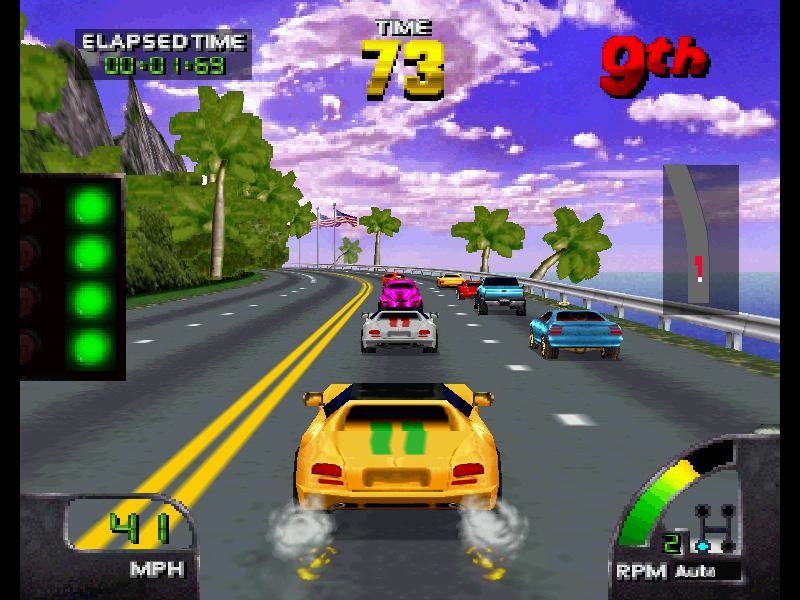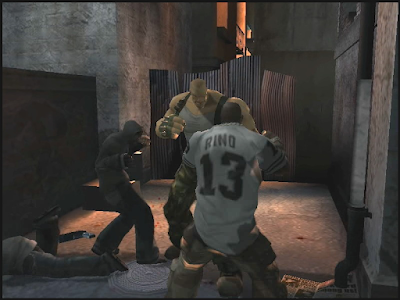What's this? An arcade racing series that made its way to handhelds using the DOOM Engine? Welcome back to THE SITH ARCHIVES OF DARTH FANDOM, and today's topic is Cruis'n, a good old arcade racing series consisting of six games and a whole lot of fun. This post will span the Nintendo 64, Game Boy Color, Game Boy Advance, Wii, Switch and of course, arcade, all in the lead up to another special arcade racing post in the future. Without further ado, let's get cruis'n.
 |
Cruiiiiiisiiiiin, yeah, Cruis'n USAAAAAA
Image credit: Arcade History
|
Cruis'n started back in September 1994, first appearing on Midway's V Unit arcade system, an arcade system consisting of only four games. Cruis'n USA, the first title in the series, is quite a simple game: pick a car, pick a track, drive. The game takes place across the USA, with you starting off in San Francisco and finishing the game in Washington, D.C. Cruis'n USA was one of two games, alongside Killer Instinct's original arcade version, to be part of Nintendo's "Ultra 64" lineup of arcade systems. Ultra 64 was eventually renamed "Nintendo 64" (the console we know today), and Nintendo ceased development for arcades. In December of 1996, Cruis'n USA was ported to Nintendo 64, albeit in a slightly different form, with a few differences: the woman who awards a trophy at the end of a race is wearing more clothes, some billboards were removed, killable animals were removed and Bill Clinton is no longer bathing with bikini girls in the back of a car. In March, 2008, Cruis'n USA was rereleased for the Nintendo Wii's Virtual Console, but before this comes the second installment in the original arcade trilogy.
 |
Bye bye, Bill.
Image credit: Atlas Obscura |
 |
Cruis'n WOOO-OOOO-OOOOOOOOORLD!
Image credit: GameFabrique |
November 1996's Cruis'n World is a vast improvement when compared to USA. While keeping the same overall style of gameplay, World is, as the title suggests, not just based in the USA. You get to race in 14 different countries (you even get to race on the Moon in the N64 version!), you have more cars to race in, up to four players can play in multiplayer and this game introduced stunts. World's June 1998 Nintendo 64 port was also more successful when compared to Cruis'n USA, and is widely regarded as the best of the N64 ports. World was the third of four games to run on Midway's V Unit system, after Cruis'n USA and War Gods, with the fourth and final title on the system being Off Road Challenge, the fourth title in Midway's Off Road series. Cruis'n World is the second game in the original trilogy of Cruis'n games, so let's talk about the third one.
 |
War Gods has a playable character called Kabuki Jo. Awesome.
Image credit: VicioJuegos / YouTube |
 |
Just look at this flyer.
Image credit: Jtalledo / Wikimedia Commons |
Cruis'n Exotica, released for arcades in 1999, is a strange game. As you can imagine, Exotica is an exotic game, and certainly changed the tone from relatively normal to all-out funky. No longer are you playing as an unseen driver hidden behind a black window in a 1963 Chevrolette Corvette, because you are now a Martian driving in some strange car with rocket boosters! Is driving on the Moon too silly for you? Well, you can drive in Atlantis, the dinosaur-infested Amazon and Mars! This third entry ran on Midway's Zeus II hardware, which was only use in one other game: The Grid, a 2000 arcade third-person shooter featuring some characters from the Mortal Kombat franchise. Exotica was also Cruis'n's debut title on handhelds, receiving a Game Boy Color on November 6, 2000. Developed by Crawfish Interactive, creators of some of my favourite Game Boy games (Street Fighter Alpha 3, Ecks vs. Sever and Ballistic: Ecks. vs Sever), Exotica on the GBC offers a similar experience to its N64 and arcade counterparts, albeit in a much more simplified and slightly less enjoyable way. Cruis'n Exotica marked the end of the Cruis'n series on Nintendo 64, but not the series as a whole.
 |
It's not the worst, but there are certainly better GBC games and ports.
Image credit: GameFabrique |
 |
We got this...
|
 |
...from this.
Image credits: World of Longplays / YouTube
Lee's Outlook / WordPress |
The Game Boy Advance saw the release of Cruis'n Velocity in November, 2001, which has quite an interesting story behind it. Velocity was developed by Graphic State, an English company who started off their business on the Game Boy Color with LEGO Stunt Rally. Their second released game, Cruis'n Velocity, ran on the engine being used for the then-in-development first-person shooter Dark Arena. Dark Arena's engine is a modified version of DOOM's Jaguar engine for GBA, which in itself is a modified version of the id Tech 1 engine. So, Cruis'n Velocity runs on the DOOM engine. Wow. If you've played Dark Arena, or even DOOM II on GBA, you may recognise some of the visual style and texture quality. In terms of gameplay, Velocity is better than Exotica's Game Boy Color port but still not quite as fun as the original N64 games. It's still quite strange why they would use a first-person shooter engine for a racing game when plenty of other racing games had come out perfectly on the GBA (V-Rally 3 is an excellent example), and the limitations of the DOOM engine do sometimes act as a detriment to Velocity as a whole. Well, that's DOOM covered. So how does Fast & Furious fit into the grand scheme of things?
Raw Thrills was formed in 2001 as an arcade game company, consisting of former Midway employees and starting off making gambling games. Raw Thrills' first title was Target: Terror, a 2004 light gun shooter for arcade systems that eventually saw release on the Nintendo Wii, published by Konami. Their second game was The Fast and The Furious, released in July, 2004, that sported oddly similar gameplay to the Cruis'n series. Like the film it is based off of, The Fast and The Furious received many sequels: The Fast and The Furious: Super Bikes, a bike-based game released in 2006; The Fast and The Furious: Drift, a game based off of the third film in the Fast & Furious franchise, released in 2007; and The Fast and The Furious: SuperCars, a spin-off released in 2010. SuperCars received a revision after the Fast & Furious license expired, and Super Bikes received two non-F&F sequels in 2010 and 2019, respectively. However, the original F&F game from 2004 received a Wii port in the form of Cruis'n in November, 2007. Cruis'n is essentially F&F 2004 but it's even worse and it's on the Wii. Well, that's Cruis'n on the Wii in a nutshell. Until 2017, it seemed like the Cruis'n series was over, but one more game was yet to be released.
 |
Spot the difference.
Image credit: The Gaming and Hobby Channel / YouTube |
 |
Cruis'n's back.
Image credit: Best Buy |
Cruis'n Blast is the latest game in the Cruis'n series, released in 2017 as Raw Thrills' 31st game. Being the first true Cruis'n game since 2001 (name changes don't count), Blast was quite exciting for Cruis'n fans. It added tons of new maps, tons of new cars, looks great graphically, the visual aesthetic is beautiful and it takes the silly factor of Exotica to a whole new level. Blast's 2017 version was good enough to receive a Nintendo Switch port, published by GameMill Entertainment (most well known for Big Rigs: Over the Road Racing) in September, 2021, almost 20 years since Velocity appeared on the GBA. Unlike previous arcade to Nintendo ports of the Cruis'n series, Blast adds in tons of new content, including 24 new maps. Never before have you been able to cruise (pun intended) through the streets of alien-invaded London as a Triceratops alongside a fire engine and a Pegasus. I'm not making that up. Cruis'n is truly at its peak with Blast, and it may be difficult to top it.
So that's the Cruis'n series, the first in a collection of blog posts on arcade racing series. I'm still divided on what I'm going to blog about next (trust me, there's a lot of stuff), but I hope that you enjoyed this blast, or should I say cruise, through the past. Well, that's a wrap on THE SITH ARCHIVES OF DARTH FANDOM!
















